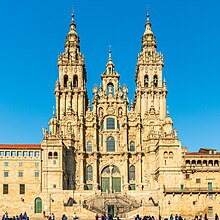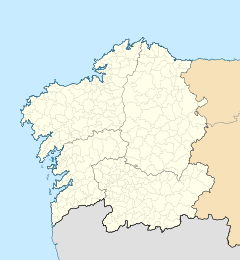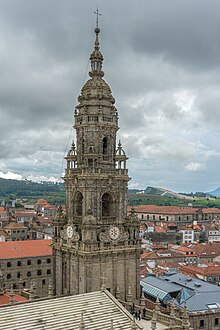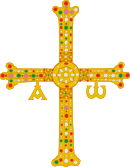
Santiago de Compostela, simply Santiago, or Compostela, is the capital of the autonomous community of Galicia, in northwestern Spain. The city has its origin in the shrine of Saint James the Great, now the Cathedral of Santiago de Compostela, as the destination of the Way of St. James, a leading Catholic pilgrimage route since the 9th century. In 1985, the city's Old Town was designated a UNESCO World Heritage Site.

James the Great was one of the Twelve Apostles of Jesus. According to the New Testament, he was the second of the apostles to die, and the first to be martyred. Saint James is the patron saint of Spain and, according to tradition, his remains are held in Santiago de Compostela in Galicia.

Ourense is a city and the capital of the province of Ourense, located in the autonomous community of Galicia, northwestern Spain. It is on the Camino Sanabrés path of the Way of St James, and is crossed by the Miño, Barbaña, Loña and Barbañica rivers. It is also known as A cidade das Burgas due to its hot springs, being one of the European cities with the greatest thermal heritage.

An archivolt is an ornamental moulding or band following the curve on the underside of an arch. It is composed of bands of ornamental mouldings surrounding an arched opening, corresponding to the architrave in the case of a rectangular opening. The word is sometimes used to refer to the under-side or inner curve of the arch itself. Most commonly archivolts are found as a feature of the arches of church portals. The mouldings and sculptures on these archivolts are used to convey a theological story or depict religious figures and ideologies of the church in order to represent the gateway between the holy space of the church and the external world. The presence of archivolts on churches is seen throughout history, although their design, both architecturally and artistically, is heavily influenced by the period they were built in and the churches they were designed for.
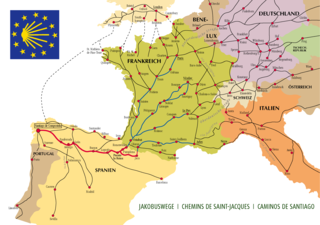
The Camino de Santiago, or in English the Way of St. James, is a network of pilgrims' ways or pilgrimages leading to the shrine of the apostle James in the cathedral of Santiago de Compostela in Galicia in northwestern Spain, where tradition holds that the remains of the apostle are buried.

The Cathedral of Saint Mary of Burgos is a Catholic church dedicated to the Virgin Mary located in the historical center of the Spanish city of Burgos. Its official name is Santa Iglesia Catedral Basílica Metropolitana de Santa María de Burgos.

The Cathedral of Saint Lazarus of Autun, commonly known as Autun Cathedral, is a Roman Catholic cathedral in Autun and a national monument of France. Famous for its Cluniac inspiration and its Romanesque sculptures by Gislebertus, it is a highlight of Romanesque art in Burgundy. It is the seat of the Bishop of Autun. The Bishop of Autun set forth the construction of St. Lazarus Cathedral as a result of the large movement of pilgrims travelling to Vezelay as they progressed on the pilgrimage route to Santiago de Compostela.

The Botafumeiro is a famous thurible used at the Santiago de Compostela Cathedral, in Spain. Its name comes from the Galician language, where botar means "to eject, to throw away, to expel", and the Latin fume, meaning "smoke".
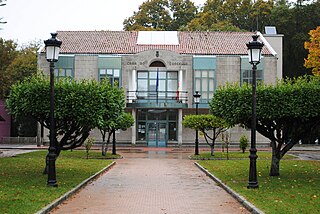
O Saviñao is a Concello (council) in the province of Lugo, Galicia belonging to the district of Terra de Lemos. The main town for the council is Escairón.

The Hostal dos Reis Católicos, also called the Hostal de Los Reyes Católicos or Parador de Santiago de Compostela, is a five-star Parador hotel, located in the Praza do Obradoiro of Santiago de Compostela, Spain. It is widely considered one of the oldest continuously operating hotels in the world, and has also been called the "most beautiful hotel in Europe".

Saint Mary's Cathedral, better known as Lugo Cathedral, is a Roman Catholic church and basilica in Lugo, Galicia, north-western Spain. The cathedral was erected in the early 12th century in a Romanesque style, with Gothic, Baroque and Neoclassical elements.

The Cathedral of Sigüenza, officially Catedral de Santa María de Sigüenza, is the seat of the bishop of Sigüenza, in the town of Sigüenza, in Castile-La Mancha, Spain. It was declared Bien de Interés Cultural in 1931.
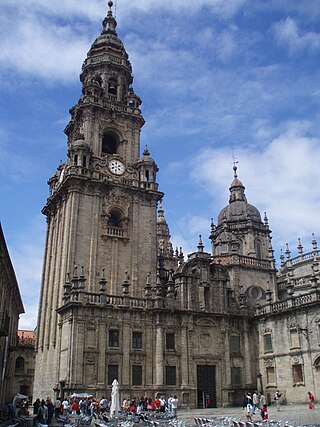
Domingo Antonio de Andrade was a Galician baroque architect, a leading figure in the emergence of Galician Baroque architecture.

The Ourense Cathedral is a Roman Catholic church located in Ourense in Galicia. Dedicated to St Martin, it was founded in 550. The first structure was restored by Alonso el Casto. The present mainly Gothic building was raised with the support of Bishop Lorenzo in 1220. Its local patroness is Saint Euphemia. There is a silver-plated shrine, and others of St Facundus and St Primitivus. The Christ's Chapel was added in 1567 by Bishop San Francisco Triccio. It contains an image of Christ, which was brought in 1330 from a small church on Cape Finisterre. John the Baptist's Chapel was created in 1468 by the Conde de Benavente. The Portal of Paradise is sculptured and enriched with figures of angels and saints, while the antique cloisters were erected in 1204 by Bishop Ederonio. The Capilla de la Maria Madre was restored in 1722, and connected by the cloisters with the cathedral. The eight canons were called Cardenales, as at the Cathedral of Santiago de Compostela, and they alone did services before the altar; this custom was recognised as "immemorial" by Pope Innocent III, in 1209. The cathedral, which has undergone an impressive transition of architectural styles of Romanesque, Gothic, Renaissance, Baroque and Neoclassical, was built to a Latin Cross plan. It has been a functional basilica since 1887. The cathedral has a crucifix that is held in great reverence all over Galicia.

The Portico of Glory of Santiago de Compostela Cathedral is a Romanesque portico and the cathedral's main gate created by Master Mateo and his workshop, on the orders of King Ferdinand II of León. The king donated to Mateo one hundred maravedís annually between 1168 and 1188. To commemorate its completion in 1188, the date was carved on a stone set in the cathedral and on the lintel that supports the richly ornamental tympanum. Under the contract made in 1168, if Mateo was to renege on the deal to create the portico at any time, he would have to pay 1,000 gold pieces (aureos). The complete three-piece set took until 1211 to completely finish; when the cathedral was consecrated in the presence of King Alfonso IX of León.
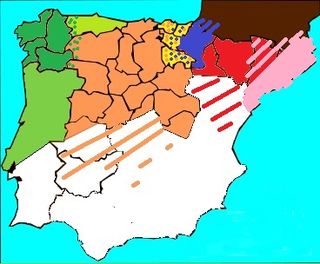
Spanish Romanesque designates the Romanesque art developed in the Hispanic-Christian kingdoms of the Iberian Peninsula in the 11th and 12th centuries. Its stylistic features are essentially common to the European Romanesque although it developed particular characteristics in the different regions of the peninsula. There is no Romanesque art in the southern half of the peninsula because it remained under Muslim rule (Al-Andalus). The examples of Romanesque buildings in the central area of the peninsula are sparse and of the latest period, with virtually no presence south of the Ebro and the Tagus. Most Romanesque buildings can be found in the northern third of the peninsula. Romanesque art was introduced into the peninsula from east to west, so scholars have usually defined regional characteristics accordingly: the "eastern kingdoms" comprising the Pyrenean areas, Catalan Romanesque, Aragonese Romanesque and Navarrese Romanesque, and the "western kingdoms" comprising Castilian-Leonese Romanesque, Asturian Romanesque, Galician Romanesque and Portuguese Romanesque.

The Praza do Obradoiro is main square of the Santiago de Compostela old town, although not placed at the real centre. It lies to the West of the main façade of the Santiago de Compostela cathedral, and thus the Pórtico da Gloria must be crossed to get into the building from the square. It is surrounded by four important buildings, said to represent the four powers of the city: the aforementioned Santiago de Compostela cathedral to the East, Hostal dos Reis Católicos to the North, Pazo de Raxoi to the West and the Colexio de San Xerome to the South. Once being crossed by cars, now is mainly pedestrian as the rest of the old town, with only traffic for taxis and (un)loading delivery lorries.
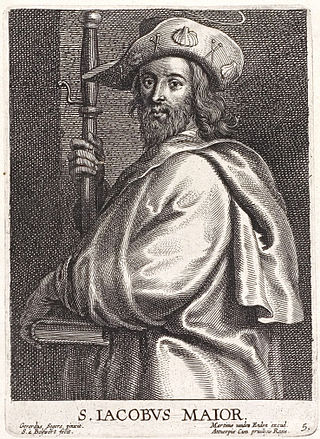
The Feast of Saint James, also known as Saint James' Day, is a commemoration of the apostle James the Great celebrated on July 25 of the liturgical calendars of the Roman Catholic church and of the Anglican, Lutheran and some other Protestant churches. The Orthodox Christian liturgical calendar commemorates James on April 30.

The Holy Door, also known as the Door of Forgiveness, is located at the rear of the Santiago de Compostela Archcathedral Basilica, in Galicia, Spain, and is opened only during a Jacobean Holy Year. During the Holy Year it remains open so that pilgrims, and others, may enter from the Plaza de la Quintana into the apse of the cathedral. Those who do so may earn a plenary indulgence.

Quintana Square is the main square of Santiago de Compostela, Galicia, Spain. It is formed by the meeting of the south facade of Santiago de Compostela Cathedral, Casa da Parra, Monastery of Saint Pelagius of Antealtares and Casa da Conga.
